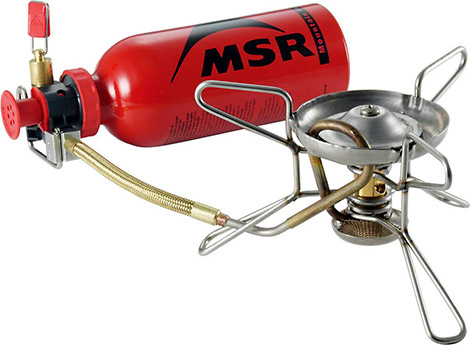Doing some snow camping this weekend and I was wondering something.
I have a white gas stove I never use because it is pain in the ass to work with and in any case is a poor choice for cooking because it only has two settings: off and thermonuclear. So it remains mothballed and I normally carry a cartridge stove.
However, I was wondering whether it might make sense to carry the white gas stove up exclusively for melting snow. I perceive that it is much hotter than the cartridge stove. Am I saving fuel weight for melting snow by carrying the white gas stove for that purpose (in other words, am I getting significantly more BTUs per oz from my white gas stove than my cartridge stove)?
My climbing partner would be carrying a cartridge stove as well, for cooking.
Stove question: white gas and cartridge
-
Hikin_Jim

- Posts: 4688
- Joined: Thu Sep 27, 2007 9:04 pm
Simonov,
Strictly, in terms of fuel, a canister/cartridge stove is going to slightly edge out white gasoline when it comes to calories per gram of fuel. But, it's a bit more complicated than that.
There are a bunch of other considerations, one of the top considerations being temperature. If it's cold enough, the gas in a canister won't vaporize, and all those potential calories are just that potential. Potential doesn't melt much snow.
Another consideration is the burner head. A larger burner head will put out more BTU's with a slightly "lesser" fuel than a smaller burner head with a slightly "greater" fuel (lesser and greater in terms of calories per gram of fuel).
Another consideration is windproofness. A lot of white gasoline stoves are "remote" style where the fuel tank is not connected to the stove directly but rather via a remote fuel hose. This remote style allows one to use a windscreen safely. The windscreen can greatly increase the amount of delivered BTU's, BTU's that might other wise be whisked away in the breeze. One can also use a heat reflector under the burner, further increasing efficiency (delivered calories per gram of fuel).
In short, even though a canister stove has slightly more potential calories per gram of fuel, the actual delivered number of calories can be considerably higher with a white gasoline stove.
Given the choice between something like a Pocket Rocket vs. something like a Whisperlite, the Whisperlite will win out, particularly in colder or windier conditions.
Long winded answer, sorry, but it's never so simple as just a choice of fuel. I could go into more, such as the brand of fuel, type of canister stove, and method of fuel delivery, but I'll stop here. If you're really interested in those subjects, take a look at my blog.
If you're really interested in those subjects, take a look at my blog.
HJ
Strictly, in terms of fuel, a canister/cartridge stove is going to slightly edge out white gasoline when it comes to calories per gram of fuel. But, it's a bit more complicated than that.
There are a bunch of other considerations, one of the top considerations being temperature. If it's cold enough, the gas in a canister won't vaporize, and all those potential calories are just that potential. Potential doesn't melt much snow.
Another consideration is the burner head. A larger burner head will put out more BTU's with a slightly "lesser" fuel than a smaller burner head with a slightly "greater" fuel (lesser and greater in terms of calories per gram of fuel).
Another consideration is windproofness. A lot of white gasoline stoves are "remote" style where the fuel tank is not connected to the stove directly but rather via a remote fuel hose. This remote style allows one to use a windscreen safely. The windscreen can greatly increase the amount of delivered BTU's, BTU's that might other wise be whisked away in the breeze. One can also use a heat reflector under the burner, further increasing efficiency (delivered calories per gram of fuel).
In short, even though a canister stove has slightly more potential calories per gram of fuel, the actual delivered number of calories can be considerably higher with a white gasoline stove.
Given the choice between something like a Pocket Rocket vs. something like a Whisperlite, the Whisperlite will win out, particularly in colder or windier conditions.
Long winded answer, sorry, but it's never so simple as just a choice of fuel. I could go into more, such as the brand of fuel, type of canister stove, and method of fuel delivery, but I'll stop here.
HJ
-
simonov

- Posts: 1102
- Joined: Tue Nov 27, 2007 5:44 pm
- Location: Reno, NV
Well, in my case the cartridge and white gas stoves will be similar configurations and sizes.
My white gas stove is an MSR WhisperLite Internationals.

My cartridge stove is an MSR Windpro.

I reckon I can keep the cartridge warm enough before I actually use it.
Doesn't sound like there is that much of an advantage to the white gas stove for simply melting snow.
My white gas stove is an MSR WhisperLite Internationals.

My cartridge stove is an MSR Windpro.

I reckon I can keep the cartridge warm enough before I actually use it.
Doesn't sound like there is that much of an advantage to the white gas stove for simply melting snow.
Nunc est bibendum
-
Hikin_Jim

- Posts: 4688
- Joined: Thu Sep 27, 2007 9:04 pm
If you've got a WindPro, then you have a much more capable stove, particularly for cold weather, than the typical canister stove. It's got a big burner head, and you can use a windscreen without blowing yourself to kingdom come.simonov wrote: Well, in my case the cartridge and white gas stoves will be similar configurations and sizes.
My white gas stove is an MSR WhisperLite Internationals.
My cartridge stove is an MSR Windpro.
I reckon I can keep the cartridge warm enough before I actually use it.
Doesn't sound like there is that much of an advantage to the white gas stove for simply melting snow.
If it's below 40F when you'll be cooking, consider using the stove in inverted canister mode (with the canister upside down). The WindPro is one of the relatively few canister stoves that can do this. Assuming you start with a fresh canister, you'll have better overall canister life with a lot less "canister fade" toward the end. You'll also be relatively immune to the cold down to at least 0F, possibly as low as -10F. In other words, don't even worry about warming the canister if you use the stove in inverted mode.
There are some notes on just how to go about going into inverted mode safely on my blog post on the WindPro.
Compared to a WindPro, there's no technical advantage to white gasoline until you get down to around -10F or lower. There are of course the usual advantages (customizing the amount in the tank, inexpensive, fire-starting, no "dead" canisters) and disadvantages (assembly, pumping, priming, frequently lack of simmering).
HJ
